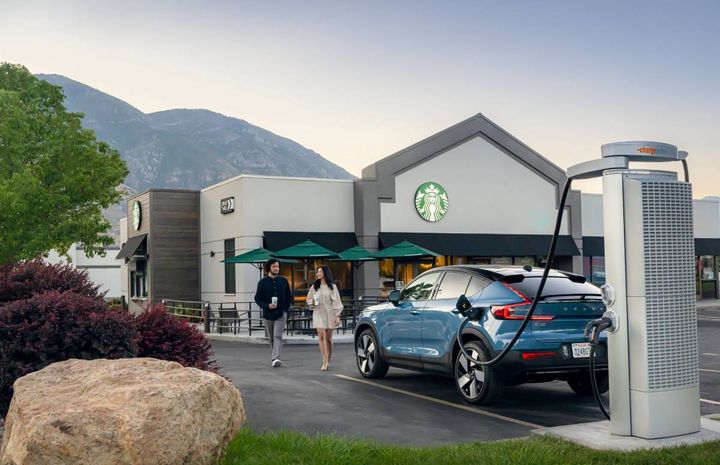
The Volvo-Starbucks-Chargepoint EV charging network gives travelers the freedom to move safely and sustainably along a previously under-resourced route for charging access across the West and Pacific Northwest.
Photo: Volvo
Volvo Cars, working with Starbucks Corporation, has installed the first electric vehicles chargers at a Starbucks store as part of a plan to create a 1,350 mile route of Starbucks-based chargers.
Powered by ChargePoint, the chargers will be available to customers and members of the public, the companies announced in an Aug. 9 news release. Four chargers are set up at the first Starbucks location in Provo, Utah and are scheduled to be activated later this month.
It will mark the start of a pilot plan announced last March to electrify a major thoroughfare that opens electric vehicle travel between four critical markets including Seattle, Boise, Salt Lake City and Denver.
With the installations of as many as 60 DC fast chargers at up to 15 Starbucks locations along a 1,350-mile route between the Colorado front range and the Starbucks Support Center (headquarters) in Seattle, Starbucks and Volvo aim to give EV drivers the freedom to move by providing familiar, comfortable and safe places to recharge their vehicles, and themselves.
Previously under-resourced to support EV charging, this scenic artery passes near six national forests and unlocks to zero tailpipe-emission EV drivers some of the country’s most iconic spots. From the Snoqualmie Pass in Washington, stretching the Snake River in Idaho, spanning Arches National Park in Utah and connecting outdoor destinations like Park City and Vail, the route represents the American road trip at its best.
By the end of the year, plans call for chargers at Starbucks stores about every 100 miles along the route, well within the range of nearly every EV, providing much-needed infrastructure for EV drivers and those considering an electric vehicle. While their cars are recharging outside, customers can relax comfortably inside with their favorite Starbucks beverage.
“Partnerships like this are important as we continue to move towards a more sustainable, electrified future,” said Anders Gustafsson, senior vice president of the Americas Region and President and CEO of Volvo Car USA. “Together with Starbucks and ChargePoint, we are creating an EV charging network that can fit seamlessly into everyday life. It’s a great compliment to Volvo Cars’ mission to give people the freedom to move in safe, sustainable and personal ways.”
“Public EV charging should be as easy as getting a great cup of coffee – and now, it can be,” added Michael Kobori, Starbucks chief sustainability officer.
ChargePoint’s DC fast chargers can bring the Volvo C40 Recharge, for example, from a 20% to a 90% charge in about 40 minutes. Drivers of Volvo Recharge models with Google embedded can use the ChargePoint app integrated into their vehicle’s in-dash system, while others can us the ChargePoint smartphone app to find and access the ChargePoint charging stations at participating Starbucks locations.
The full list of communities that will have EV chargers at Starbucks store locations along the route includes the Washington cities of Seattle, Issaquah, and Yakima; Hermiston and La Grande, both in Oregon; Nampa, Twin Falls and Uintah, all in Idaho; Sandy and Provo, Utah; and the five Colorado towns of Grand Junction, Glenwood Springs, Silverthorne, Idaho Springs, and Broomfield.
“With Volvo and Starbucks, we’re creating a premium EV driving experience between the Rocky Mountains and the Pacific Northwest with Starbucks and Volvo Cars,” said Pasquale Romano, CEO of ChargePoint. “Through our partnership, EV drivers will have the opportunity to quickly fuel their vehicles at Starbucks locations along one of America’s most scenic byways.”
While drivers of any EV equipped with a standard CCS1 or CHAdeMO receptacle will be able to use these stations for a fee, drivers of Volvo Cars will receive the added benefit of having access to these stations at no charge or at preferential rates.
Just as Volvo Cars plans to be a fully electric car company by 2030, Starbucks is reimagining the store experience for greater connection, ease, and planet positive impact. The company continues to rapidly expand its roster of renewable energy and decarbonization projects in the U.S in support its global goal to reduce its carbon footprint by 50% by 2030.
Originally posted on Charged Fleet
